Spring
season of births
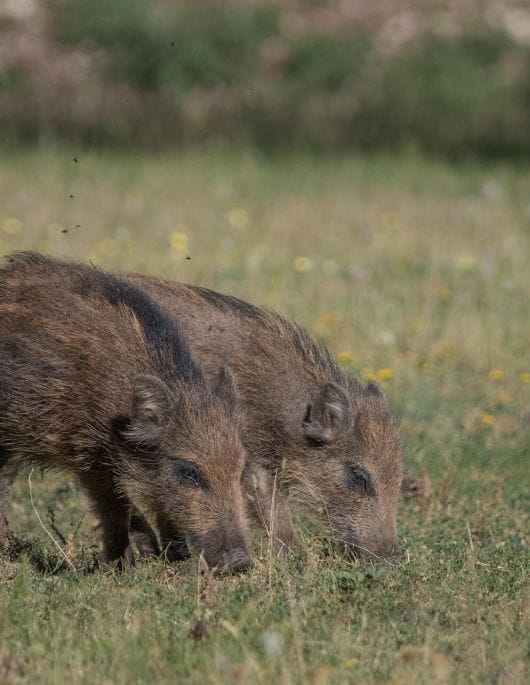
March
wild boar piglets are the first one to roam the Reserve
Sows give birth at the beginning of March. Their gestation lasted 3 months, 3 weeks and 3 days, about 115 days.
The female gives birth to two or three young boars, more rarely to four or five. After a week, the little ones in their striped coats are able to follow their mother in her quest for food, until the age of one to two years
It is common to meet these small families, at the beginning of March, around our domestic horses, probably to seize cereals and forage pellets abandoned in the meadows.

May
first fawns are lurking in the undergrowth
Beginning of April,deer look for a place protected by dense vegetation that will be a refuge for the newborn fawn when the mother goes away.
In the Reserve, calving starts in late April and ends in early June. After 8 months of gestation, the doe gives birth to a fawn. Around the same time, the roebuck (deer females) separate from their young (s) from the previous year to search for an isolated place where they give birth to one to two young. During the first weeks of life, fawns spend most of the time hidden from predators in tall grasses or shrubs. Mothers often join them to nurse and groom them.
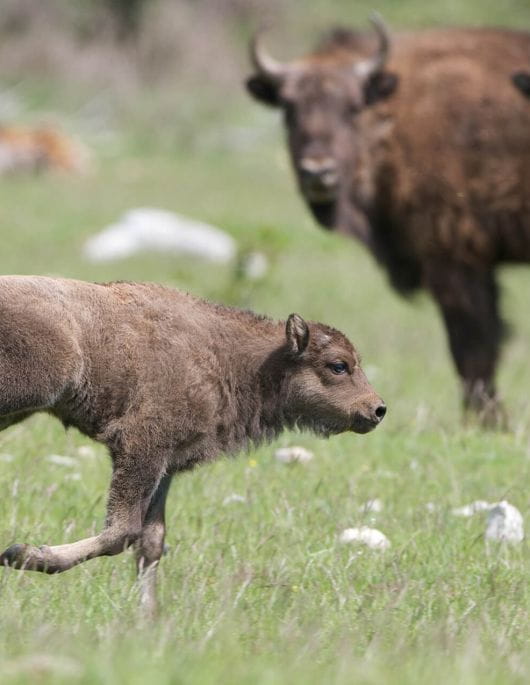
June
calves gallop
In June, young bison gallop roaming the meadows. The herd of bison remains intact even during the period of births. After nine months of gestation, females ready to give birth leave the herd to reach a higher altitude site protected by a dense “forest” of boxwood.
Two to three days after being isolated from the group, the females give birth to a single calf, weighing 12 to 15 kg (26 to 33 pounds). Then, they return to the herd when the calves seem smart enough to join the other young with whom they constitute a “nursery”.
Summer
a calm and easy life
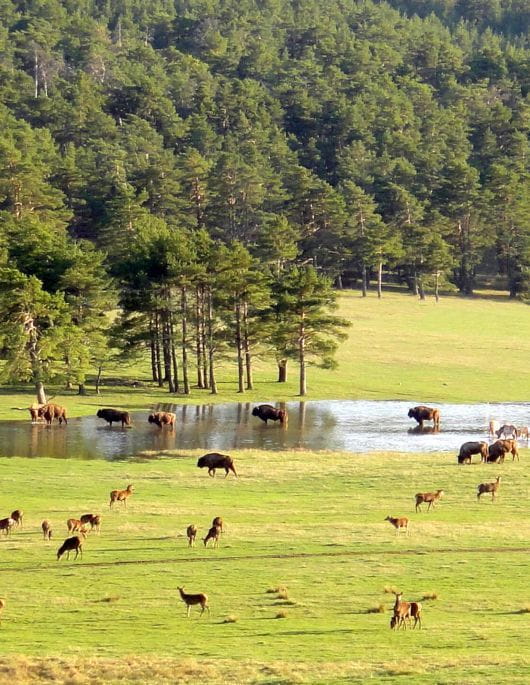
End of June
mothers produce milk
Herbivores take advantage of summer favors to replenish their fat reserves. During the hot hours, they take refuge in the forest, otherwise they prefer to occupy the plains where food abounds. Pastures are neither cultivated nor mowed. Bison, horses and deer provide this agricultural work and stimulate biodiversity by promoting creation of meadows and lawns where more than 40 plant species flourish!
This spectacular evolution of the flora is not limited to open spaces. It is found in forest areas where bison have made their way. In place of a Mediterranean forest with Scots pines, appear wood meadows reminiscent of those encountered above 1600 meters (5249 feet) in the neighboring Mercantour.
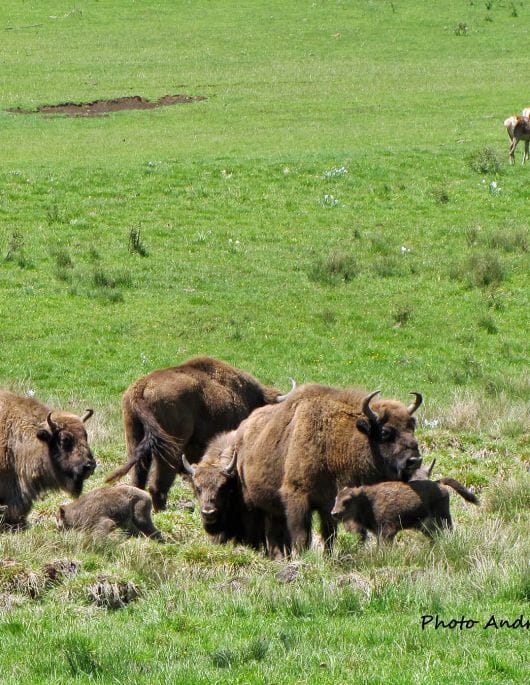
In July
wild herbivores transform landscapes
Bison graze all environments. With their power, they open clearings in the forest where wild horses and deer shape bushes which were not accessible by grazing them. Wild boars complete the work by plowing the undergrowth. This way, they accelerate the aeration of the soil and the germination of the seeds of pioneer plants so far dormant.
The newly opened spaces are then colonized by smaller animals, such as chamois, deer or hare. Beginning in June, it is not uncommon during guided tours to meet goats or deer seeking to draw attention to themselves in order to divert visitors from their young, carpeted in the vegetation. Our guides are then instructed to play the game and “follow” the mother to be “intentionally lost” by her.

August
the discreet mating season of the bison
Summer advancing, the hot weather fades. The first storms open their floodgates to revive the meadows. The female bison begin to stir. The mating season is soon here. By mid-August, early and non-lactating females enter heat. They are joined by the males who offer their service with a delicacy that could inspire some!
The male bison immediately spot the behavioral change of the females. He must then accurately assess the hormonal status of his “darling”. For this, he has an infallible detection organ, located just behind the palate, Jacobson’s organ. This is why he regularly smells the genital area of the female and, like an oenologist, he sucks by mouth pheromones emitted by the female.
If he thinks it is the right time for the mating , the male spends all his time with the female, accompanying her everywhere, sometimes for several days. Until the beauty accepts his advances.
Fall
deers are in love
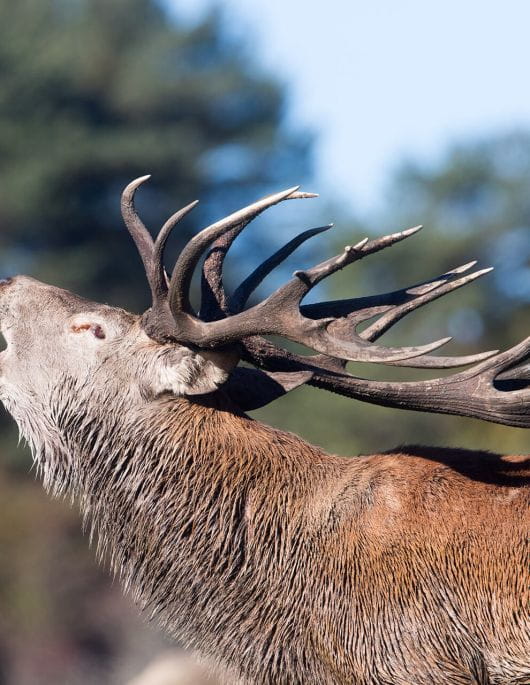
In September
the pre-mating call
In late summer, the deer come out of the forest. The most vigorous, generally solitary, mark the young trees by rubbing against them violently. Young males intrigued by the action of the elders, gather in herds. They have fun simulating the games of adults.
Meanwhile, deer continue to roam the Reserve until the male’s first raucous cries in early September. Reflected by the mountain, the deer’s bellows set off all the wildlife. Roe deers, wild horses and wild boars move carefully. Only the bison seem to live with the agitation that inspires even the youngest of them. It is not uncommon at this time to observe two- and three-year-olds copying their elders.

In October
love madness
The lover’s ballet continues until the end of October, the deer going, according to their desires, place to place. This polyandry practice ensures the genetic variability of their offspring. Sometimes a distracted male or a curious female approaches a little too close to a deer courted by a buck
The charge of this one is immediate and woe to the imprudent one who would be stuck in the abdomen, because an injury can lead to death. Deer fighting is spectacular, but rarely fatal. The opponents first defy the voice, then antlers against antlers. They repel each other in turns until the weakest gives way. A female is not worth dying for , especially as the doe do not hesitate to deceive the winners with the vanquished!
Winter
the time of survival
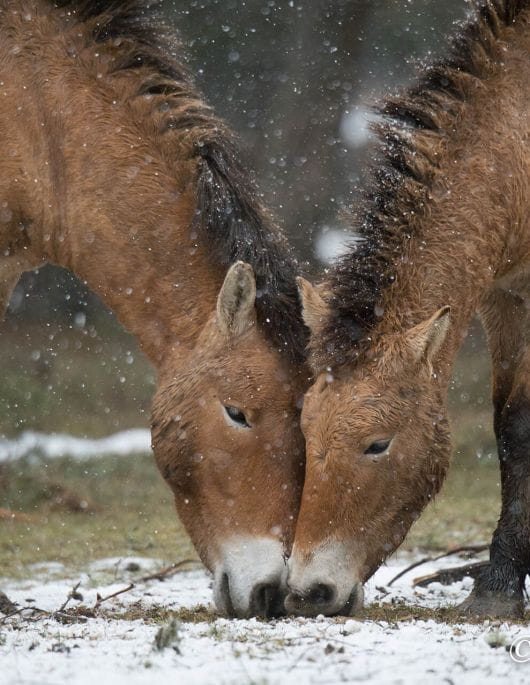
In November
the herbivores scrape…
From November, the autumnal sweetness gives way to alpine freshness. The days are still pleasant but at night the mercury may falls below zero. In December there are sometimes night temperatures of -10 ° C. Still beautiful sunny days remind the proximity of the shore.
Grass and plants that feed on herbivores desert the plains. By mid-November, the hungry wildlife is gaining undergrowth where it knows how to find the food uneaten during the beautiful season
They manage to feed themselves by scraping the last grasses even dry, by looking for the few islands of persistent greenery or by picking the fruits of the eglantiers and the hawthorns. Before the great starving of January and February, no question of being difficult!
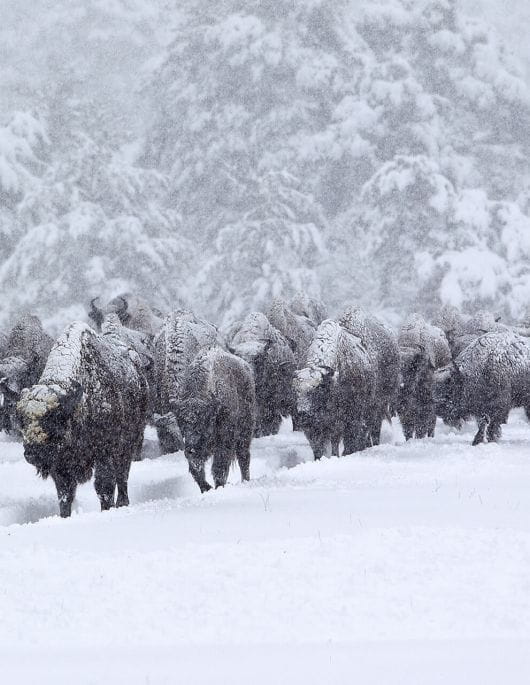
December
avoid deprivation
Some years, the snow carpet is so thick that it makes it futile to search food on the ground. The animals must be satisfied with the above the ground resources : lichens, pine needles, evergreen broom or box leaves, and, above all, bark. Those foods with no consistency just calm their hunger. Except wild boars that do not touch this type of food and pay a heavy tribute to long snow period. In 2009, up to 3/4 of the boar population died in the high country!

January
In the heart of winter, the quest for water becomes a priority. Ponds and streams are covered with a thick layer of ice that animals must break. The food has become very rare. In the past, before humans looped through nature, animals migrated to find safe havens.
Today, when the winters are harsh, we must feed the wildlife if we do not want to condemn it permanently. It is common in eastern countries and we practice in the reserve when the snow exceeds 50 centimeters …
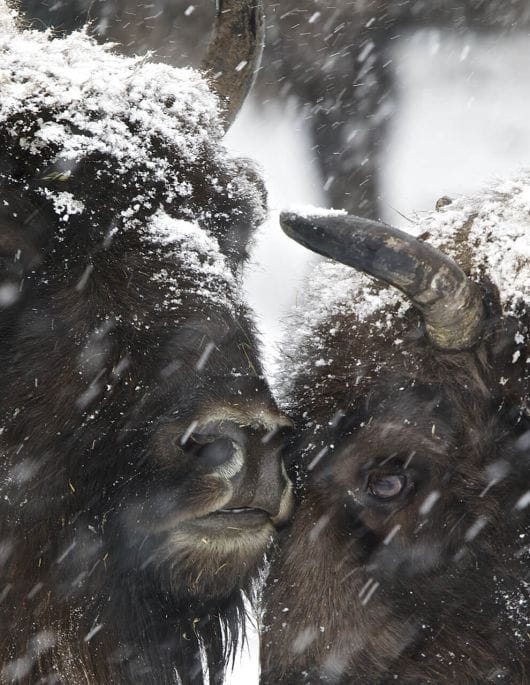
The bison diet
During the winter, the bison has trouble feeding his several quintals large body . So he is careful not to use up the accumulated fat reserves during the summer. It’s vital for him ! He reduces his movements . The flock gets together, the animals huddle to keep warm. In this way, they can better cope with extreme February temperatures that can drop below -20 ° C (-4°F).
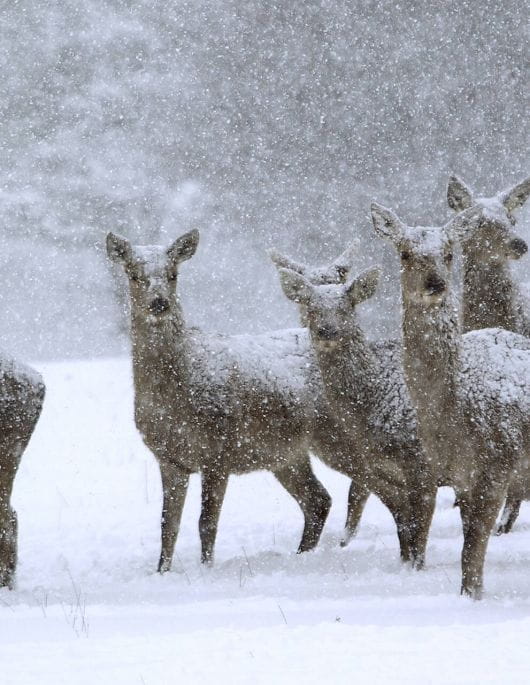
Cervid nutrition
Whole cervid herds, male, female, and mixed young, often accompany bison groups. By breaking branches, shrubs or ice, bison offer unexpected access to resources for deer. This can be seen as inter-species cooperation.

Przewalski’s horse diet
Przewalski’s horse seems to be best suited to these difficult conditions. He tirelessly travels the reserve munching on everything that is within his reach. Its relatively small size and the reserves of fat disseminated in all its muscles allow it to support the most frugal rations. In March, he is barely thin. Unlike other species!
When winter ends
at the Reserve
When winter is over, most animals have lost weight. The fat reserves have been consumed. This slimming is essential to trigger the breeding period at the right time. Several mild winters often cause offspring births in the fall. Which are dramatic for young born too late and unable to resist the cold weather.
Winter is a key season for the perpetuation of adults. It eliminates animals that are too weak or sick and sometimes healthy adults.
Watch out for climatic excesses. A harsh winter can decimate the breeding generations, a winter too mild endanger the next generation. Decidedly, life is a fragile balance!